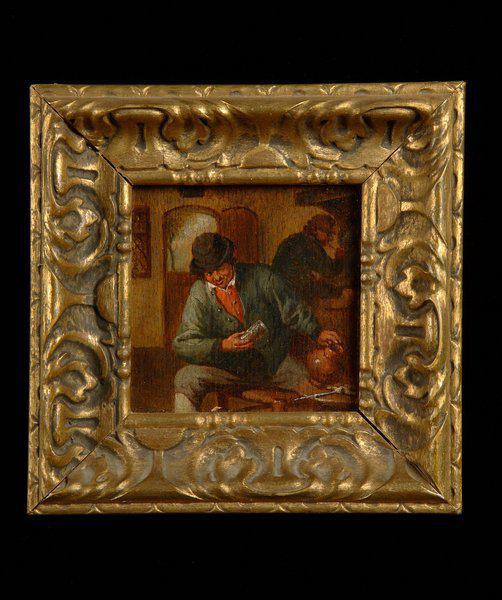Circle of David Teniers, A peasant in a tavern
10103
DAVID TENIERS, the elder (1582-1649), was born at Antwerp. Having received his first training in the painter's art from his brother Juliaen, he studied under Rubens in Antwerp, and subsequently under Elsheimer in Rome; he became a member of the Antwerp gild of painters in 1606. Though his ambition led him at times to try his skill in large religious, historical and mythological compositions, his claim to fame depends chiefly on his landscapes and paintings of peasants carousing, of kermesse scenes and the like, which are marked by a healthy sense of humour, and which are not infrequently confused with the early works of his son David.
DAVID TENIERS, the younger (1610-1690), the more celebrated son of the last-named, almost ranking in celebrity with Rubens and Van Dyck, was born in Antwerp on the 15th of December 1610. His touch is of the rarest delicacy, his color at once gay and harmonious. He seems anxious to have it known that, far from indulging in the coarse amusements of the boors he is fond of painting, he himself lives in good style, looks like a gentleman, and behaves as such. He never seems tired of showing the turrets of his chateau of Perck, and in the midst of rustic merry-makings we often see his family and himself received cap in hand by the joyous peasants. Teniers was chosen by the common council of Antwerp to preside over the gild of painters in 1644. The archduke Leopold William, who had assumed the government of the Spanish Netherlands, being a great lover of art, employed Teniers not only as a painter but as keeper of the collection of pictures he was then forming. Immense sums were spent in the acquisition of paintings for the Few artists ever worked with greater ease, and some of his smaller pictures have been termed "afternoons," not from their subjects, but from the time spent in producing them. The museums in Madrid, St Petersburg, Vienna, Munich, Dresden, Paris, London and Brussels have more than 200 pictures by Teniers. In the United Kingdom 150 may be found in private hands, and many other examples are to be met with in private collections throughout Europe. Although the spirit of many of these works is as a whole marvellous, their conscientiousness is be regarded as questionable. Especially in the later productions, from 1654 onwards there is a lack of earnestness and of the calm and concentrated study of nature which alone prevent expression from degenerating into grimace in situations like those generally depicted by Teniers
Van Tilborgh, who was a scholar of Teniers in Brussels, followed his style with some success, and later painters often excelled in figure-painting on a small scale. Properly speaking, he is the last representative of the great Flemish traditions of the 17th century.
Oil on panel
Dutch










